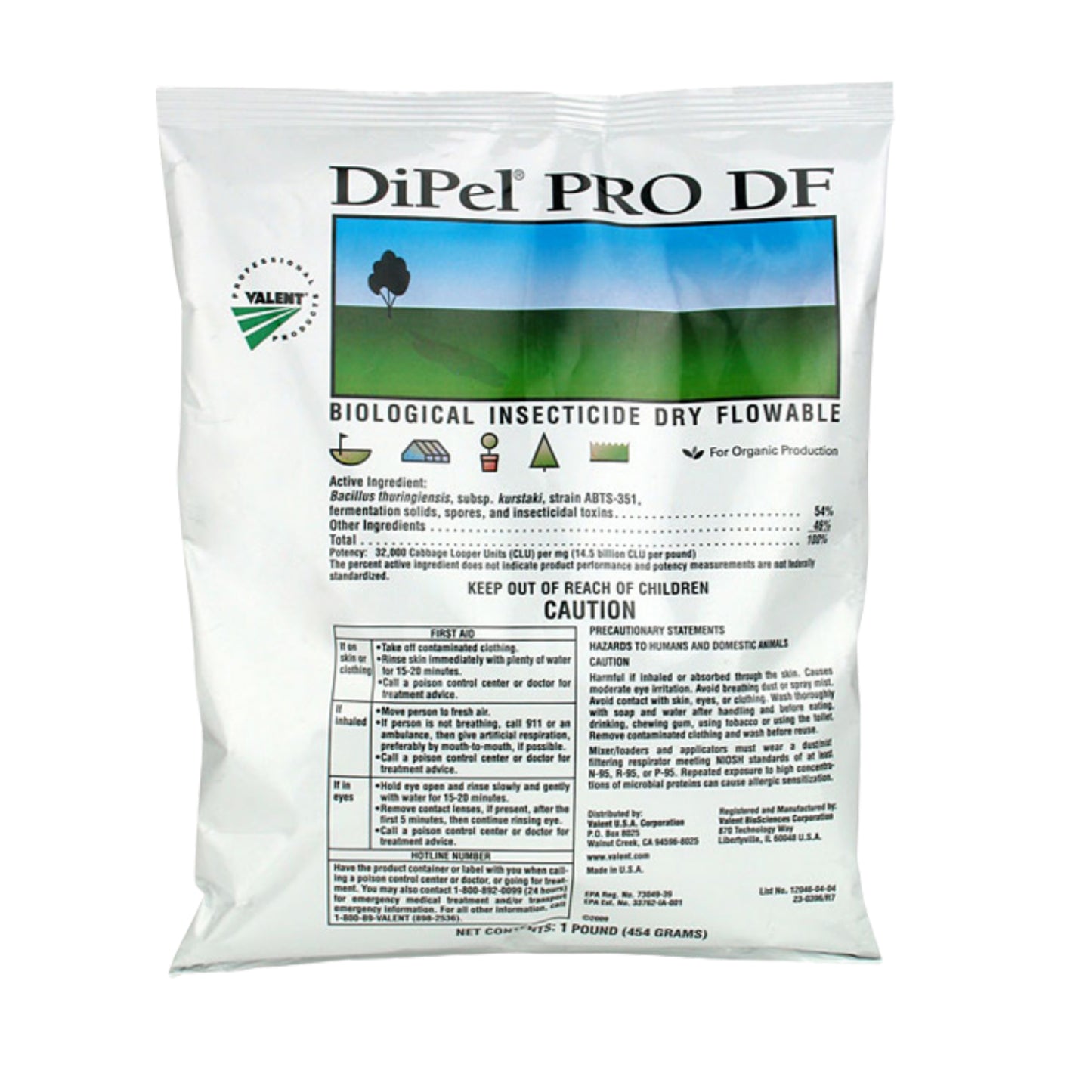
DiPel PRO DF Caterpillar Control for Hydroponics
DiPel PRO DF uses Bacillus thuringiensis var. kurstaki (Btk) to target caterpillars and moth larvae in Hydroponics and traditional gardens, stopping feeding within hours and preventing further damage. Its dust-free dry flowable (DF) formula mixes easily and applies cleanly across ornamentals, turf, fruits, vegetables, and herbs. Because Btk is highly pest-specific, it spares beneficial insects and pollinators, supporting robust Integrated Pest Management (IPM) programs.
OMRI Listed Btk Biological Insecticide
Backed by a 0-day pre-harvest interval and a 4-hour REI, DiPel PRO DF lets growers maintain quality and harvest schedules without delay. Use at early larval stages for best results against armyworms, bagworms, budworms, loopers, webworms, and more Lepidopteran species. Consistent applications during periods of active feeding help protect canopies, sustain vigor, and boost overall crop performance in Hydroponic systems.
Features:
-
Targeted Lepidopteran control (armyworms, loopers, budworms, webworms) without harming beneficials.
-
OMRI Listed biological insecticide suitable for organic-minded Hydroponics programs.
-
Rapid feeding cessation within hours; visible control follows as larvae succumb.
-
Versatile label across ornamentals, turf, fruits, vegetables, and herbs—great for mixed operations.
-
Clean, dust-free dry flowable for easy measuring, mixing, and IPM compatibility.
This Product Controls These Pests or Diseases: Armyworms (Pseudaletia unipuncta), Beet Armyworm (Spodoptera exigua (Hubner)), Black Cutworm (Agrotis ipsilon (Hufnagel)), Bollworm (Helicoverpa zea), Broccoli Worms; Imported Cabbage Worm (Pieris rapae), Cabbage Butterfly (Pieris rapae), Cabbage loopers (Trichoplusia ni), Cabbage Moth, Cabbage Army Moth (Mamestra brassicae), Cabbage worms (Pieris rapae), Celery Worm (aka Parsley Worm, Parsnip Butterfly, Eastern Black Swallowtail, American Swallowtail) (Papilio polyxenes), Cherry Fruit Worm (Grapholita pacakardi), Codling Moth (Cydia pomonella), Corn Borer (aka European Corn Borer) (Ostrinia nubilalis), Corn Borer (aka Southwestern Corn Borer) (Diatraea grandiosella), Corn Earworm (Helicoverpa zea), Cutworms (Agrotis, Amathes, Peridroma, Prodenia spp), Diamondback moth (Plutella xylostella), European Corn Borer (aka Corn Borer) (Ostrinia nubilalis), Fall Armyworm (Spodoptera frugiperda), Fall Canker Worms, Inchworms (Alsophila pometaria), Fall Webworm (hyphantria cunea), Fruit Worm (mult), Grape Leaf Folder (Desmia funeralis), Grape Leafroller (Erythroneura variabilis), Spongy Moth (Lymantria dispar), Hickory Shuckworm (Cydia caryana), Hornworms (Manduca sp), Inch worm (Mult), Indian Meal Moth (Plodia interpunctella), Iris Borer (Macronoctua onusta), Leafrollers (Archips argyrospila), Leafroller (Platynota stultana), Leafroller (Choristoneura rosaceana), Leafroller (Pandemis pyrusana), Leafroller (Argyrotaenia franciscana), Leafroller (Epiphyas postvittana), Lucerne Moth (Nomophila noctuella), Omnivorous leafroller (Platynota stultana), Orange tortrix (Argyrotaenia (=citrana) franciscana), Orangeworm (Amyelois transitella), Oriental Fruit Moth (Grapholitha molesta), Parsleyworm (Papilio polyxenes asterius), Pink Bollworm (Pectinophora gossypiella), Plume Moth (Platyptilia sp), Red-banded Leafroller (Argyrotaenia velutinana), Sod Webworm (Mult), Sperry's Lawn Moth (Crambus sperryellus), Spring Canker Worms, Inchworms (Paleacrita vernata), Squash Vine Borer (Melitta curcurbitae), Tent caterpillars (Malacosoma americanum), Tobacco Budworm (Heliothis virescens), Tomato Fruitworm (Helicoverpa (Heliothis) zea), Tomato Hornworm (Manduca quinquemaculata), Tomato Pinworm (Keiferia lycopersicella), True Armyworm (Pseudaletia unipuncta), Walnut Caterpillar (Datana integerrima), Webworms (Hyphantria cunea), Western Lawn Moth (Tehama bonifatella)

